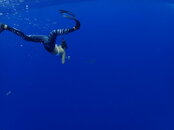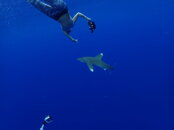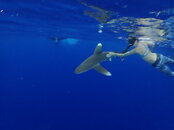drrich2
Contributor
You mentioned a number of things worth unpacking.
Thanks for the info. Regional differences in temperment/behavior are good to know of. I've read elsewhere that while in the U.S. we regard sand tiger sharks are pretty benign, in some parts of the world, they don't.
Of those, the oceanic white tips are the ones that seem a particularly odd choice for free-diving. I've heard of them coming at divers, the importance of maintaining eye contact, the intensity of diving with them at times...
Big issue there - at what size does a given shark species become a concern (if you're not handling food)? That oceanic white tip that took out that guy's calf didn't look over 6 feet to me, if that. I get the impression their 'danger size' is smaller than for some species?
There's also the matter of, for lack of a better term, personality. The photo with the tiger going at a washing machine drum was from French Polynesia; after coming across four or five different tigers in two days there I came away feeling like the ones at Tiger Beach must be gulping down marijuana bales on a regular basis.
Thanks for the info. Regional differences in temperment/behavior are good to know of. I've read elsewhere that while in the U.S. we regard sand tiger sharks are pretty benign, in some parts of the world, they don't.
I know people who freedive with tigers, bulls, makos, oceanic whitetips
Of those, the oceanic white tips are the ones that seem a particularly odd choice for free-diving. I've heard of them coming at divers, the importance of maintaining eye contact, the intensity of diving with them at times...
With oceanic whitetips we were explicitly told not to dive down on them as even the little ~5 footer had a "bring it" reaction
Big issue there - at what size does a given shark species become a concern (if you're not handling food)? That oceanic white tip that took out that guy's calf didn't look over 6 feet to me, if that. I get the impression their 'danger size' is smaller than for some species?






